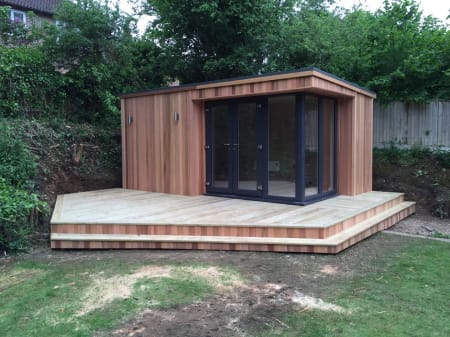Timber Decking For Garden Rooms
Timber decking is a popular option for garden rooms because it is relatively inexpensive and easy to install.
Additionally, it is durable and can be stained or painted to match the aesthetic of the surrounding landscape.
Timber decking also provides a natural look and feel that can be used to complement a garden room.
Advantages of timber decking include its cost-effectiveness, durability, and versatility. Garden room timber decking is typically less expensive than composite or PVC decking options, making it a great option for those on a budget. Timber decking is also durable and can withstand heavy foot traffic and weather conditions. This means that it will last for many years with proper maintenance.
Another advantage of timber decking is its versatility. It can be stained or painted to match the surrounding landscape or to complement the colour of the garden room. Additionally, timber decking can be cut and shaped to fit any space, making it a great option for small or irregularly shaped gardens.
Disadvantages of garden room timber decking include its tendency to rot or warp over time, and its susceptibility to termites and other pests. Timber decking requires regular maintenance to ensure that it lasts for many years. This includes cleaning, staining, and sealing to protect the wood from the elements.
Another disadvantage of garden room timber decking is that it may be prone to rot or warp over time. This can be caused by exposure to moisture, which can cause the wood to expand and contract. Additionally, timber decking is susceptible to termites and other pests, which can cause significant damage to the wood if left unchecked.
Finally, timber decking is not as environmentally friendly as some other decking options. It is a natural resource and can be sustainably grown and harvested, however, it does not have the same level of recycling potential as composite decking.
Overall, timber decking is a great option for those looking for a cost-effective, durable, and versatile solution for a garden room. It can be stained or painted to match the surrounding landscape, and it can be cut and shaped to fit any space. However, it does require regular maintenance, may be prone to rot or warp, and is not as environmentally friendly as some other options.
What Are The Best Types Of Timber Decking For A Garden Room
The best type of wooden decking will depend on your specific needs and preferences. Some popular choices include:
Pressure-treated lumber: This type of wood is treated with chemicals, such as copper azole or alkaline copper quaternary, to prevent rot and insect damage. It is often used for framing and structural support for garden room decks, but can also be used for decking boards. Pressure-treated lumber is a cost-effective option and can last for many years with proper maintenance. However, it does have some downsides. The chemicals used in the treatment process may be harmful to the environment, and it can be harder to work with because of its rough texture and tendency to warp. Additionally, the chemicals used in pressure-treatment can cause a strong odour, and it is recommended to wear gloves and masks while working with it.
Cedar: This type of garden room timber decking is naturally resistant to rot and insects, and it has a warm, natural colour. It is also lightweight and easy to work with. Cedar is a great option for garden room decks in areas with moderate climates, as it performs well in moist environments. However, cedar can be more expensive than pressure-treated lumber, and it may not be as durable in areas with extreme weather conditions.
Redwood: Similar to Cedar, Redwood is also naturally resistant to rot and insects, and it has a similar colour to cedar. It is known for its stability and durability. Redwood is considered to be one of the most durable and longest-lasting decking materials for garden room decking, it is also dimensionally stable which means it is less prone to warping and twisting than other types of wood decking. Redwood is also a more expensive option than pressure-treated lumber and cedar.
Ipe: This type of wood is a hardwood that is extremely durable, and resistant to rot, decay, and insects. It is known for its dark colour and high density. Ipe is a great option for garden room timber decking in areas with extreme weather conditions, as it is highly resistant to moisture and insects. Ipe is also a very hard wood, making it more difficult to work with, but it is also long-lasting and requires less maintenance than other types of garden room wood decking. Ipe can be also more expensive than other options.
In conclusion, choosing the best type of wooden decking for your garden room will depend on your budget, the climate in your area, and your personal preferences. Each type of wood has its own advantages and disadvantages, and it is always a good idea to consult with our sales advisors to determine which option is the best for your specific garden room needs.
